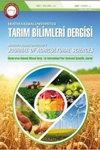采收时间对土耳其几种柠檬和柑橘种子含油量和脂肪酸组成的影响
IF 1.1
4区 农林科学
Tarim Bilimleri Dergisi-journal of Agricultural Sciences
Pub Date : 2016-12-12
DOI:10.15832/tbd.77425
引用次数: 3
摘要
柑橘类水果,通常加工成果汁。柑橘类水果榨汁后的主要残留物是果皮和种子。为了评估种子的替代用途;测定了4种柑桔(Citrus reticulata)和3种柠檬(Citrus limon)的油脂含量和脂肪酸组成与采收期的关系。不同品种和不同采收期的柑桔样品中油脂含量和脂肪酸组成差异显著(P<0.05)。这些种子的含油量为21.66% ~ 37.75%。这些结果表明,柑橘种子比许多油籽含有更多的油。柑橘籽油由八种不同的脂肪酸混合而成。柑桔中亚油酸含量最高(35.64 ~ 37.39%),柠檬籽油中油酸含量最高(32.99 ~ 36.39%)。这些结果表明,柑橘种子在脂肪酸组成方面可以作为食用油来源和其他工业领域的价值。本文章由计算机程序翻译,如有差异,请以英文原文为准。
The Effect of Harvesting Time on Seed Oil Content and Fatty Acid Composition of Some Lemon and Mandarin Cultivars Grown in Turkey
Citrus fruits usually processed into juice. The main residues are peel and seeds for citrus fruits after juice production. In order to evaluate the seeds for alternative usages; the oil content and fatty acid compositions of four mandarin (Citrus reticulata) and three lemon cultivars (Citrus limon) were determined with respect to their harvesting times. Oil content and fatty acid compositions of the samples were significantly (P<0.05) varied depends on cultivars and their harvesting times for each citrus species. Oil content ranged from 21.66 to 37.75% for these seeds. These results revealed that citrus seeds contain much more oil than many oil seeds. The citrus seeds oil combined from eight different fatty acids. The highest fatty acid was determined as linoleic acid (35.64-37.39%) for mandarin and oleic acid (32.99-36.39%) for lemon seed oil. These results revealed that citrus seeds could be valued as an edible oil source and other industrial area with respect to fatty acid composition.
求助全文
通过发布文献求助,成功后即可免费获取论文全文。
去求助
来源期刊
CiteScore
1.40
自引率
0.00%
发文量
26
期刊介绍:
Journal of Agricultural Sciences (JAS) is an international, double-blind peer-reviewed, open-access journal, published by the Faculty of Agriculture, Ankara University. The journal invites original research papers containing new insight into any aspect of Agricultural Sciences that are not published or not being considered for publication elsewhere. Preliminary, confirmatory or inconclusive research, review articles, case and local studies and works presenting taxonomy will not be published.

 求助内容:
求助内容: 应助结果提醒方式:
应助结果提醒方式:


